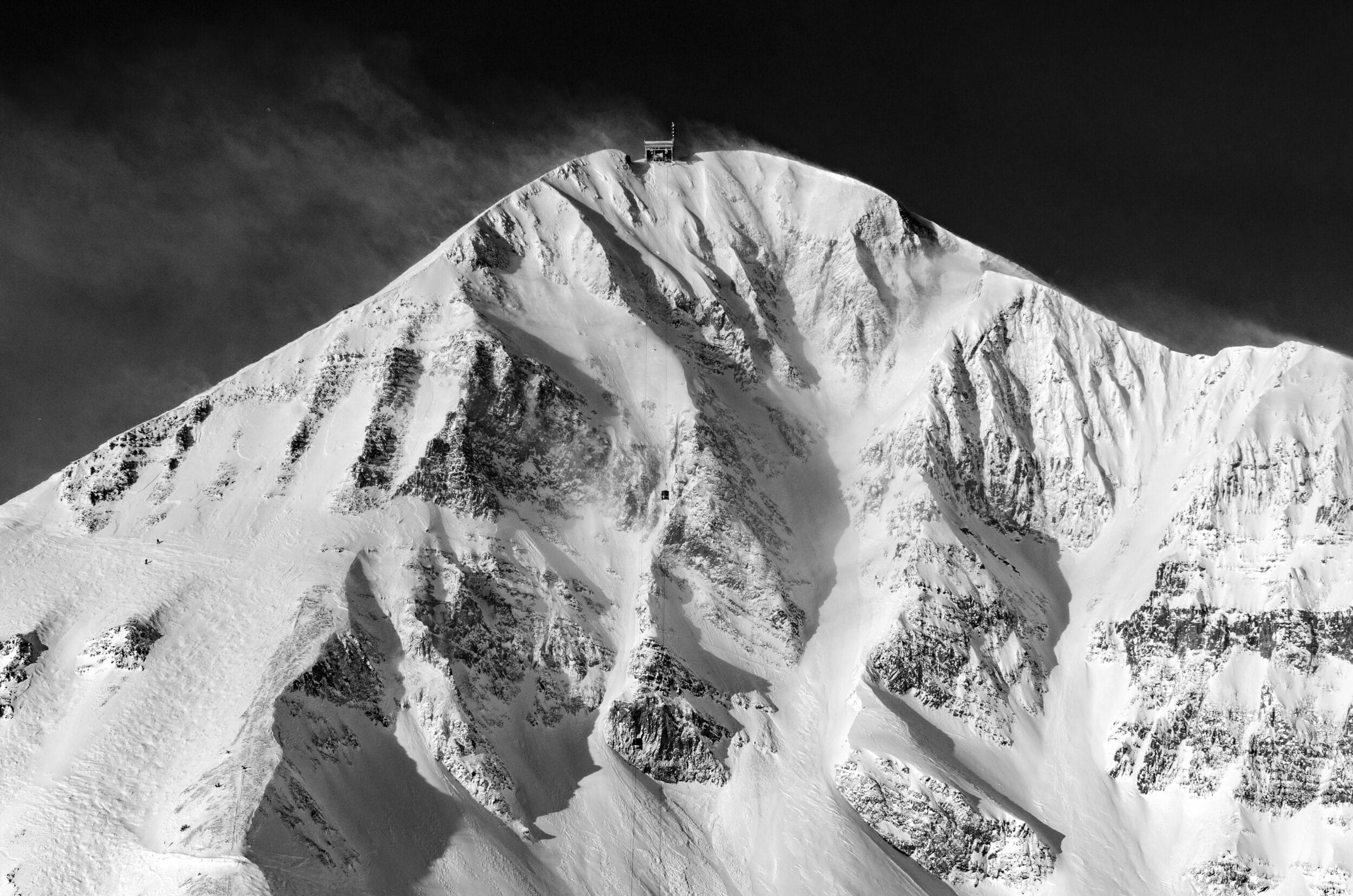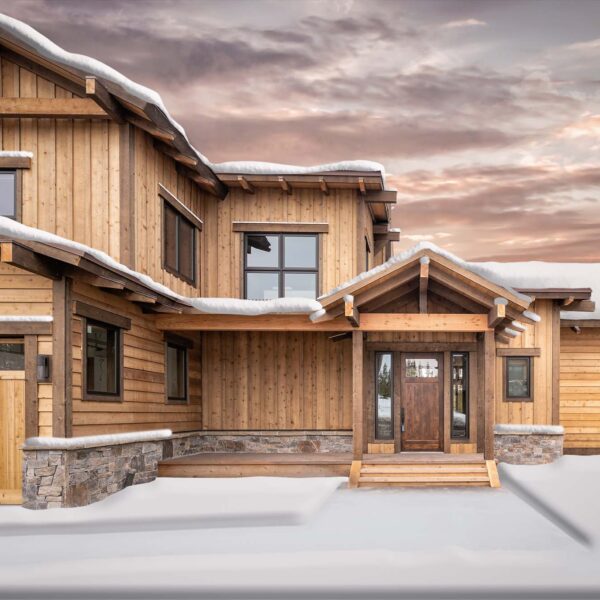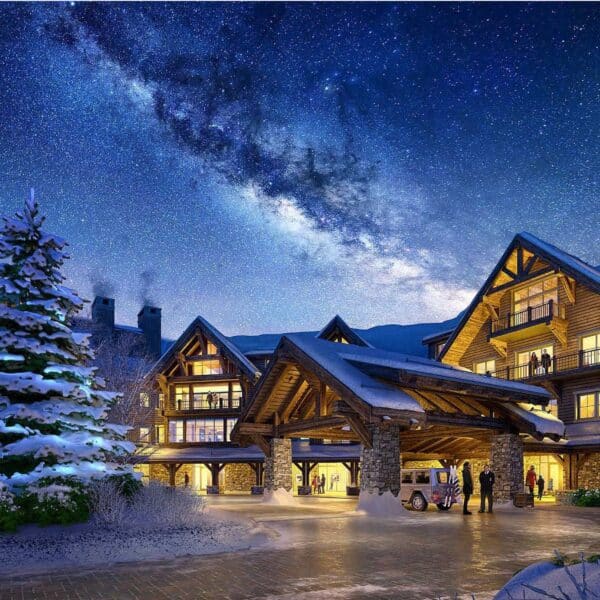Big Sky, Montana

What’s in a Name? The Lone Peak Couloirs
An iconic tram, a rugged Rocky Mountain summit,
and a famously hairball ski line. Nope, not Jackson Hole. We’re talking Big Sky Resort, where the north and east faces of Lone Mountain (the official name) pack some of the most extreme lift-accessed terrain in North America. Here, the resort’s pièce de résistance—Big Couloir—drops more than 1,400 vertical feet below a 50-degree entrance and around a high consequence dogleg. “It’s so cool up there,” says Scot Schmidt, the father of American-style big mountain skiing and star of more than 40 films. Schmidt, who grew up in Helena, first explored Big Sky just after the resort opened in 1973. As a teenager he watched as a skier crashed in Big Couloir—and kept on crashing. “He cartwheeled down it, bouncing off the walls, and I thought, ‘Wow, that’s what happens when you fall on something like that.’ That left a mark on me.”
Man’s Best Friend
Early on, Big Couloir was, for a while, rebranded as “Smitty’s Couloir.” Despite some healthy conjecture, that’s not a reference to Schmidt. Rather, the name pays homage to a mutt, Smitty, who notched the first canine descent of Big Couloir in the late 1970s. A proper powder hound, the story holds that the dog dropped in first.
Go Little
Down the ridge from Big Couloir, a smaller, steeper, and spicier line hides out: Little Couloir. “Compared to the Big, the Little is like going from the freshman team to varsity,” says Dave Stergar, a retired teacher from Helena who’s been skiing Lone Peak for more than three decades. If Little Couloir is open, it’s likely at the Apple Core, an alternate entrance to skier’s left that drops you into the main line. Stergar once fell twice during one descent of Little Couloir with patrollers and his wife watching. When she pointed out that he’d gone down, the patrollers told her it couldn’t be Dave because “he wouldn’t fall in there.” Stergar says: “I got up, skied down, and immediately skied it again because you gotta get back on the horse.”
Three First Descents
The skier—and Big Sky Resort employee—Mark Kalitowski was the first to shred Big Couloir. The date? June 23, 1973. Not long after, in 1975, Kalitowski and the alpinist and patroller Dougal McCarty notched the oblique entrance to the more technical Little Couloir via that near hanging face dubbed the Apple Core because they’d shared an apple before dropping. They followed the fall line traced by the apple core they tossed down the chute. In the winter of 1981, Kalitowski and Jon “Yunce” Ueland (who started with ski patrol in 1979) claimed the first descent of Little Couloir’s direct entrance.
Why the Lone Face?
Why the heck is Lone Peak so solitary? Known as a laccolith, the mountain is a volcano that never erupted. Instead, magma rose between layers of sediment and solidified into dacite, an igneous rock slightly darker than granite. The intrusion process also baked the surrounding sandstone into a harder form: shale. So as the softer sedimentary mass eroded around it, the dacite-shale formation emerged as a promontory. If you clip a piece of dacite on your way down Big Couloir, you’ll notice something. It doesn’t move.
Fire and Ice
Although it looks like an act of divine intervention, Big Couloir wasn’t etched by Ullr. Erosion and glacial ice carved the accents, couloirs, and cirques into Lone Peak. In fact, a rock glacier—talus and ice—underlies about a mile of terrain below the tram, including the lower tram house. Evidence? The seemingly random pile of rocks below Big Couloir, known as “the Cue Ball,” is actually part of the Lone Peak Rock Glacier. The talus insulates the ice while gravity pulls them both downhill.
Watch the Mountain
You need avalanche gear, a partner, and a check-in with ski patrol to descend Big Couloir and the adjacent North Summit Snowfield. To set yourself up, keep a constant eye on the weather and take a good look at the line to see what the snow’s doing. That way, you’ll be ready to nail that steep, exposed first turn—or go somewhere else. Schmidt recommends watching the sastrugi to follow snow deposits. If you feel dialed, enter Big Couloir uphill and skier’s right of the common entrance to milk it for three extra-smooth, wind-buffed turns.

Real Estate: Breaking Ground
Spanish Peaks Location: Encompassing 3,350 mountainous acres in Big Sky, Montana, and less than an hour south of Bozeman Airport. About: More than a destination, living in Big Sky is a lifestyle. No crowds, no traffic, and proudly underdeveloped. The Spanish Peaks community features all anyone needs to be entertained in the town: an 18- hole […]

How Montage Big Sky’s Residences Are Elevating The Montana Ski Town’s Luxury Offerings
Montage Big Sky is Montana’s first-ever ultra-luxury, five-star resort, set to open in 2021. Like most Montage Hotels and Resorts, the property will have luxury ownership opportunities, which includes 39 two-bedroom to six-bedroom residences ranging from $5 million to $18.6 million. Future residents will have access to all of the hotel’s luxury amenities, as well […]

The Best Places to Travel in March, From Cuba to Greenland
Big Sky, Montana If you think ski season is over by the time March rolls around, think again: Montana’s Big Sky Resort doesn’t close its slopes until late April, meaning you can still enjoy prime conditions during this month. Big Sky features an incredible 5,850 acres of skiable terrain, with sizable portions dedicated to both beginner and […]